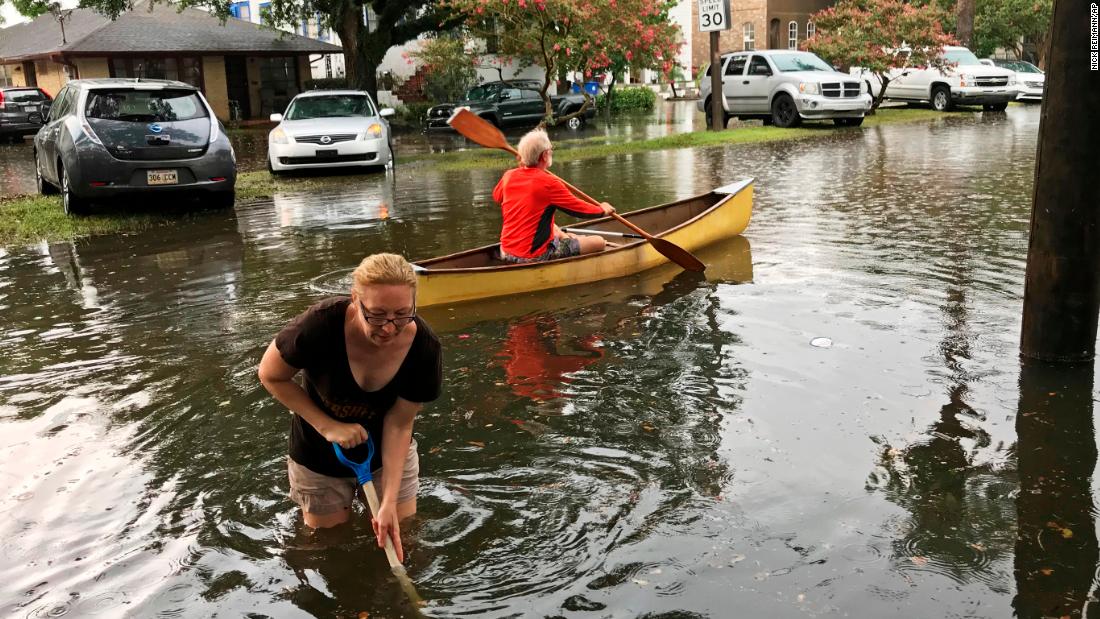[ad_1]
In the meantime, Barry is spinning away in the Gulf of Mexico, threatening a storm surge of 2 to 3 feet at the mouth of the river, said Jeffrey Graschel, a hydrologist with the weather service’s Lower Mississippi River Forecast Center in Slidell, Louisiana.
“This is the first time we’ve had a tropical system with water levels on the river this high,” he said.
The prediction is rattling the nerves of residents also concerned about the 10 inches of rain Barry could dump before it moves out, CNN senior meteorologist Dave Hennen said. That deluge would follow the 9 inches that fell Wednesday in New Orleans, flooding parts of the city.
Mandatory evacuations in at least 2 parishes
Barry, set to be the first tropical system to hit the United States this year, is moving slowly, the weather service said. Residents of the coast and in the lower Mississippi Valley could see heavy rainfall through the weekend and into early next week, with flash flooding, river flooding and storm surge likely.
“Look, there are three ways that Louisiana floods: storm surge, high rivers and rain,” Gov. John Bel Edwards said Thursday. “We’re going to have all three.”
New Orleans has not issued mandatory or voluntary evacuations, Mayor LaToya Cantrell said. An evacuation typically wouldn’t be considered until the storm was a Category 3, she said, and for now, the strategy is to shelter in place.
The US Army Corps of Engineers has insisted that it does not expect overtopping of the city’s levees under the forecast conditions and said Thursday that it is “extremely confident in the integrity of the system.”
Officials are expected to close dozens of floodgates to help mitigate the risk of flooding, according to Southeast Louisiana Flood Protection Authority East spokesman Antwan Harris, and the Federal Emergency Management Agency has deployed personnel and supplies for staging in Louisiana and Texas, it said in a statement.
“Gulf Coast residents should prepare now for heavy rains, flooding and high wind impacts regardless of this storm’s category,” the FEMA statement said.
In New Orleans, 118 of city 120 pumps that drain neighborhoods are in working order, Sewerage & Water Board spokeswoman Courtney Barnes said. The two that aren’t are relatively small, she said, and are at stations with other functioning pumps in the Lakeview area and New Orleans East.
Still, the system of pumps, underground pipes and canals is designed to remove only 1 inch of rainwater in the first hour of a storm and a half-inch in subsequent hours. It simply could not keep up with Wednesday’s downpour, Barnes said, noting that any system in the country would have been outpaced.
“There’s no system designed to pump that capacity of rain,” she said.
‘The real storm hasn’t even hit’
Some residents aren’t taking any chances.
Dannie Davis of New Orleans will evacuate, she said Thursday. She was struck by the flooding Wednesday, “and the real storm hasn’t even hit,” she said.
“I haven’t seen this much rain and flooding before a hurricane in a while,” she said. “Who knows what’s to come and whether the city will be able to handle it.”
Another resident, Claire Grogan, was also planning to evacuate.
For 40 years, she’s lived in the French Quarter, mere blocks from the Mississippi River, she said, and has never been scared. Now, that’s changed.
“The river is so high that I am just scared to stay,” Grogan said, adding that as a business owner, she also wants her employees to have the chance to leave if they want to.
Other residents, like Sarah Corsiatto, were still weighing their options.
She said she’d heard the chatter around town about evacuating, but the co-owner of the Arrow Cafe was still making coffee for a handful of customers Thursday.
“I’ll make my decision tomorrow around 2,” she said.
CNN’s Michael Nedelman contributed to this report.
[ad_2]
Source link



